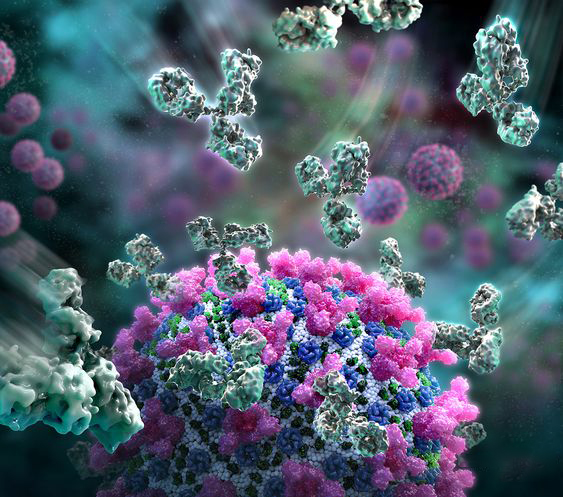MHC Series Proteins
Cytokines and Growth Factors
Cytokines are a broad and loose category of small proteins important in cell signaling. Cytokines typically exert their functions by interacting with specific cytokine receptors on the target cell surface. Growth factors are secreted biologically active molecules that can affect the growth of cells. This definition has become expanded to include secreted molecules that promote or inhibit mitosis or affect cellular differentiation. Growth factors can act on specific cell surface receptors that subsequently transmit their growth signals to other intracellular components and eventually result in altered gene expression. Some growth factors are small peptides called cytokines. While all cytokines affect signal transduction pathways, only those cytokines affecting cell growth/differentiation signaling pathways are considered growth factors.
Receptor Proteins
Receptor proteins refer to a class of proteins that can bind with extracellular specific signaling molecules (ligands) to mediate cellular signal transduction. Receptor proteins are located in the cell membrane, cytoplasm, and nucleus. Upon binding with ligands, they undergo molecular conformational changes, leading to alterations in the cellular state. Membrane receptor proteins are transmembrane proteins, including glycoproteins and lipoproteins, which are typically divided into three parts: the extracellular domain, the transmembrane domain, and the intracellular domain.
CD Proteins
The term CD (Cluster of Differentiation) translates to clusters or groups of differentiation, also known as leukocyte differentiation antigens. These refer to cell surface markers that appear or disappear on various lineages of white blood cells during different stages of normal differentiation, maturation, and activation processes. They are mostly glycoprotein molecules. Physiologically, CD molecules often serve as important receptors or ligands on cells and as cellular markers for immune antigen recognition. However, some CD proteins are unrelated to cell signaling, but play roles in cell adhesion, activation, or inhibition.
Viral Proteins
Viral protein refers to both the products of the genome of a virus and any host proteins incorporated into the viral particle. Viral proteins are grouped according to their functions, and groups of viral proteins include structural proteins, nonstructural proteins, regulatory proteins, and accessory proteins.Viruses are non-living and do not have the means to reproduce on their own, instead depending on their host cell's machinery to do this. Thus, viruses do not code for most of the proteins required for their replication and the translation of their mRNA into viral proteins, but use proteins encoded by the host cell for this purpose.
Enzymes
Enzymes are proteins that act as biological catalysts by accelerating chemical reactions. The molecules upon which enzymes may act are called substrates, and the enzyme converts the substrates into different molecules known as products. Almost all metabolic processes in the cell need enzyme catalysis in order to occur at rates fast enough to sustain life. The International Union of Biochemistry and Molecular Biology have developed a nomenclature for enzymes, the EC numbers. Each enzyme is described by "EC" followed by a sequence of four numbers which represent the hierarchy of enzymatic activity.
CAR-T Therapy Target Proteins
Chimeric antigen receptor T (CAR-T) cell therapy is a major breakthrough in cancer treatment, especially against hematological malignancies, which results in significant, long-term anti-tumor effects with higher target specificity. CD19 and BCMA are the most common targets for CAR-T cell therapy, and many new therapeutic targets are being explored. CAR is a genetically engineered artificial receptor molecule whose function is to guide immune effector cells (such as T lymphocytes) to recognize and eliminate cells expressing specific target antigens, resulting in T lymphocyte activation and a powerful anti-tumor response.
Immune Checkpoint Proteins
Immune checkpoints are key regulatory factors of immune system function. Acting as inhibitory pathways, they are crucial for maintaining self-tolerance and for regulating the duration and extent of immune responses in peripheral tissues. The development of antibody drugs targeting immune checkpoints for the treatment of cancer, tumors, autoimmune diseases, and other conditions has become an important strategy in immunotherapy. Immune checkpoint proteins are a series of molecules that generate co-stimulatory or inhibitory signals during immune responses. They hold a significant position in the field of cancer immunotherapy research. For instance, cytotoxic T lymphocyte-associated antigen-4 (CTLA-4), programmed death-1 (PD-1), and its ligand (PD-L1) are currently the most widely used targets for immune checkpoint inhibitors.
Fluorescent Proteins
Green fluorescent protein (GFP) is a protein that exhibits bright green fluorescence when exposed to light in the blue to ultraviolet range. In cell and molecular biology, the GFP gene is frequently used as a reporter of expression. GFP can be introduced into animals or other species through transgenic techniques, and maintained in their genome and that of their offspring. To date, GFP has been expressed in many species, including bacteria, yeasts, fungi, fish and mammals, including in human cells. Red fluorescent protein (RFP) is a fluorescent protein homologous to green fluorescent protein, and can emit red fluorescence under ultraviolet light.
Others




